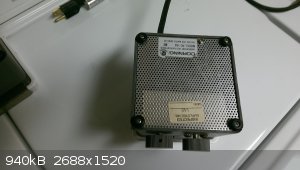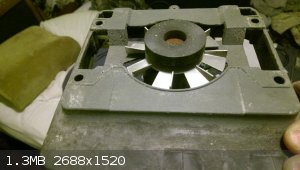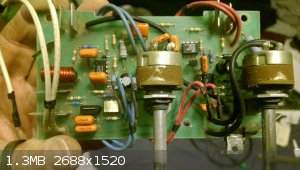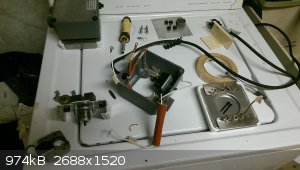
soma - 23-6-2017 at 02:01
I've got 2 magnetic stirrers. They both heat up after being on for over an hour. This is a problem because I want to run a reaction for over 12 hours
stirring at room temperature and this would raise the temperature beyond what I want.
Is it normal for mag stirrers to heat up like that?
One of them is a combination stirrer hot plate and the other is just a stirrer.
alking - 23-6-2017 at 07:01
How hot are we talking? Mine will sometimes generate electricity with prolongued stirring but never any heat. Is it possible to work around, say
insulating the base of your flask with something with poor thermal conductivity? You could also put it in a water bath to help maintain the temp and
switch it out if it gets warm.
soma - 23-6-2017 at 14:11
I had been thinking of using insulating material. The stirrer gets to around 40C. The stirrer/hotplate gets to over 50C. Hopefully, the wires inside
the stirrers aren't going to melt.
alking - 23-6-2017 at 15:03
I wonder why it gets so hot. I can't imagine it's simply from friction alone, or at least not by design, that seems so wasteful. That's a substantial
amount of heat generated simply from rotating a small piece of metal.
soma - 24-6-2017 at 00:50
I'm thinking of taking it apart and oiling it.
violet sin - 24-6-2017 at 09:12
You don't have it on any kind of dimmer circuit by chance do you? Or is it a sketchy power source supplied to your work space?
The stirrers often use shaded pole induction motors, which are built with an intended frequency and voltage in mind. Dimming them with circuitry
not built in or specific to the motor can be problematic = heat or lack of torque. Likewise, I assume if your work shop is an out building with a
long extension cord or under rated standard wiring, there may be too much voltage drop.
Other than that, I'd say something's wrong. Pretty darn hot for a stirrer or shaded pole motor. They are usually just laminated core with a diecast
pot-metal ends for holding the rotor. Not much to heat up by friction. But lubrication isn't a horrible thing. Some have an oiling point built in,
others have sealed bearings and won't help. have seen a bronze looking babbit bead trapped in oiled felt as a bearing, others have standard roller
bearings and more of course. They are in things like bathroom fans, microwave exhaust, oven hood and more for many years... Lots.
Good luck
soma - 25-6-2017 at 02:22
I took it apart and it doesn't seem to need oil. The motor looks like a small standard fan type. It's not on a dimmer and the outlet it's plugged into
is 20A 110V 3 wire.
I think the problem with it (this is mag stirrer without a hot plate), is that they didn't put any vent holes to cool it. (And, of course, there's no
vent fan on the bottom of the motor either.)
I'm thinking of drilling some holes in it at some point.
It's a Fisher Scientific stirrer. Seems fairly old. Got it from ebay for $25.
[Edited on 25-6-2017 by soma]
violet sin - 25-6-2017 at 14:03
Which one is it? Model number please. I find this interesting as I've been trying to fix up a few hotplare stirrer combos. Just replaced the cord
on one and checked function, strong heating but the stirring is slow unless maxed out. Of the four I have, so far only That one has a brain, others
are dumb wired potentiometer/rheostat controls. But I did leave it running without any noticeable heat generated. These are ceramic top, cast
aluminum body with only aluminum mesh (Al plate with lots of holes) as a ventilation opening.


Little guy on left, bigger one on the right, you can see fins around the stirrer magnet, forcing cooling down through mesh bottom shown in left pic.
Both types have similar bottom material.


< Brain's < , > no brain's >
You can see the inherent simplicity of the right pic. Just some resistors, rheostats, terminal block and motor/heating element. Now the fella on the
left, has feedback senses, zero voltage crossing IC, triac a thermocouple etc..
So any way I'm digging working on these, but just have limited time. The dumb version seems like problems = mechanical, switch, resistor or winding
based. Smart ones could be much more like old capacitors, failing triac's, etc. Etc. Etc... But I have a ton of pics, and I'm working on mapping out
the circuit (last night), populate the schematic soon with parts/values.
While working on them, I left the slow brainy one running for 2 hrs with out noticible heat. think these are corning PC-162 and PC-320.
soma - 26-6-2017 at 02:21
The label on it says cat no.: 14-511-2
Aleksa - 7-11-2017 at 15:16
Maybe the magnet is inducing eddy currents in the plate?
Melgar - 7-11-2017 at 16:59
50C is nothing for an electric motor. The ONLY bad thing that could happen is that prolonged heating could demagnetize the permanent magnet(s).
Polymers usually have to be at least 100C to melt significantly (ie, not just slightly warp).
Put like, an aluminum pan on top of the stirrer, and it'll function as a heat sink, and everything will stay cool. Put a small amount of water in the
bottom if you think it'd help.
[Edited on 11/8/17 by Melgar]
